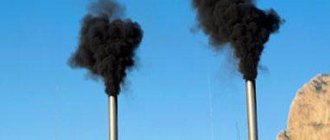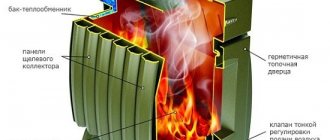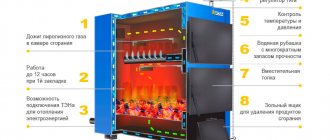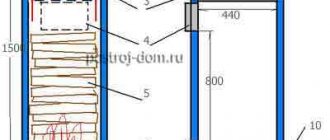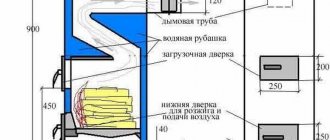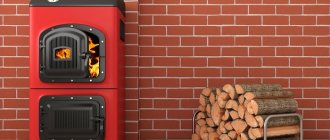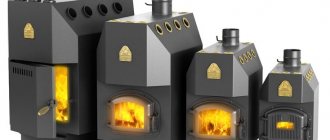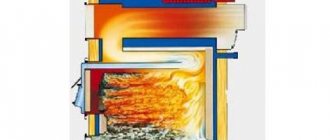Fuel and its combustion
The main source of energy for the metallurgical industry is fuel.
Fuel is understood as a substance whose combustion is accompanied by the release of a significant amount of heat and which meets the following requirements:
- reserves must be sufficient to make them economically profitable to extract and use;
- combustion products must be easily removed from the combustion zone;
- combustion products must be harmless to the environment and the thermal devices themselves;
- The combustion process must be easily controlled.
These requirements are met by organic compounds containing carbon C and hydrogen H and their compounds.
All types of fuel are divided into natural and artificial, each of which in turn is divided into solid, liquid, and gaseous.
Chemical composition of the fuel.
Fuel consists of combustible mass and ballast. Combustible components include C, H, S (organic and pyrite sulfur). The fuel composition includes nitrogen N (does not burn, coolant), oxygen O (oxidizes flammable components).
In addition, the fuel always contains water and ash. The water contained in the fuel is divided into hygroscopic, chemically bound and external, which is mechanically retained in the fuel and lost during drying.
Ash is a non-combustible mineral part of the fuel, consisting of Al2O3, Fe2O3, Si2O3, CaO, etc.
Elementary fuel analysis.
| Index | Compound | ||||||
| C | H | O | N | S | A | W | |
| ABOUT | organic mass | ||||||
| G | combustible mass | ||||||
| WITH | dry weight | ||||||
| R | working weight | ||||||
Working fuel composition:
CP + HP + OR + NP + SP + AP + WP = 100%
Conversion of the fuel composition from any mass to working fuel is performed using one of the following expressions:
Heat of combustion of fuel.
The amount of heat released when burning fuel is related to the chemical composition of the fuel.
The amount of heat that is released when a unit of fuel is burned is called the heat of combustion of the fuel Q. Its dimensions are: kJ/kg (kcal/kg), kJ/m3 (kcal/m3) or kJ/kmol (kcal/kmol).
In technology, a distinction is made between the highest Qb and the lowest Qn heat of combustion of fuel. The lower calorific value is understood as the amount of heat that is released when a unit of fuel is burned to complete combustion products, provided that the water contained in the combustion products is in the form of steam, cooled to 20 ° C.
The heat of combustion of fuel is determined by the following formulas:
for solid and liquid fuels:
for gaseous:
,
where CP, HP, CO, H2, etc. – fuel components, %;
4, 187 kJ = 1 kcal.
Conditional fuel.
For the convenience of planning, accounting and comparison of different types of fuel, the concept of standard fuel has been introduced, which is characterized by a lower calorific value
.
To convert natural fuel into conventional fuel, the equivalent of this fuel is found:
for solid and liquid:
for gaseous:
.
Recalculation of natural fuel consumption Вр per conditional Ву is carried out according to the formula:
Gaseous fuel.
Gaseous fuel compared to solid and liquid fuels has the following advantages:
- the possibility of better mixing of gas with air and, therefore, combustion with less excess air;
- ease of heating before burning;
- lack of ash;
- transportability and ease of gas consumption metering;
- ease of maintenance of burner devices.
Disadvantages: explosion hazard, low volumetric mass (requires large storage containers).
Natural gas is the cheapest fuel. Its main flammable component is methane CH4 = 95%.
Artificial gases:
- coke oven gas – a product of coal coking;
flammable components – H2 = 46-60%; CH4 = 20-30%; MJ/m3;
- blast furnace (top) gas is obtained during blast furnace smelting and contains about 30% CO; MJ/m3.
Liquid fuel.
Natural liquid fuel is oil. It is rarely used as fuel.
Artificial liquid fuels are products of oil refining: gasoline, naphtha, kerosene, gas oil, etc. The remainder of the refining is fuel oil. Fuel oil is the fuel of the metallurgical industry and energy. Before combustion, fuel oil is heated to 70-80°C in order to reduce its viscosity. The composition of fuel oil is carbon compounds. C = 85-88%; H2 = 10%; MJ/kg.
Solid fuel.
These are hard and brown coals, anthracite, oil shale, and peat.
The main method of coal processing is coking, which consists of dry distillation of fuel by heating coal without air access at temperatures of 900-1100 ° C in coke ovens. The result is sintered coke, porous, mechanically strong, used in metallurgy, mainly for smelting cast iron. C content = 75-85%; MJ/kg.
Thermal balance of the combustion process. Calculation of combustion temperature
Combustion temperature refers to the maximum temperature to which combustion products are heated. In engineering and firefighting, a distinction is made between theoretical, calorimetric, adiabatic and actual combustion temperatures.
The theoretical combustion temperature is the temperature at which the released heat of combustion of a mixture of stoichiometric composition is spent on heating and dissociation of combustion products. In practice, the dissociation of combustion products begins at temperatures above 2,000 K.
The calorimetric combustion temperature is the temperature that is achieved during the combustion of a stoichiometric combustible mixture, with an initial temperature of 273 K and in the absence of losses to the environment.
Adiabatic combustion temperature is the temperature of complete combustion of mixtures of any composition in the absence of heat loss to the environment.
The actual combustion temperature is the combustion temperature achieved under real fire conditions. It is much lower than theoretical, calorimetric and adiabatic, because in real conditions, up to 40% of the combustion heat is usually lost to radiation, underburning, heating of excess air, etc.
Experimental determination of the combustion temperature for most flammable substances presents significant difficulties, especially for liquids from solid materials. However, in a number of cases, the theory makes it possible to calculate the combustion temperature of substances with sufficient accuracy for practice, based only on knowledge of their chemical formula, the composition of the initial combustible mixture and combustion products.
In the general case, the following dependence is used for calculations (approximate, since:
Qпг = Vпг ×Ср ×Тг,
(20)
where Qpg
— enthalpy of combustion products;
Vpg
— amount of combustion products, m3/kg;
Wed
- average volumetric heat capacity of the mixture of combustion products in the temperature range from
T0
to
Tg
, kJ/(m3×K);
Tg
— combustion temperature, K.
The enthalpy of combustion products is determined from the heat balance equation:
Q pg = Qh + Q out – Qpot,
(21)
where Q sweat = Q and + Qlow + Qdiss
. (22)
Depending on the type of heat loss taken into account in the combustion zone (radiation, underburning, dissociation of combustion products), one or another temperature is calculated.
During kinetic combustion of gas-vapor-air mixtures, heat loss from the combustion zone is negligible, therefore, for these mixtures, the actual combustion temperature is close to adiabatic, which is used in fire-technical calculations.
It is very difficult to determine the average heat capacity of a mixture of combustion products. Approximately, the enthalpy of a mixture of combustion products can be expressed as the sum of the enthalpies of its components:
Q pg = S (V pg)i (Cr)i × Tg,
(23)
where (Vpg ) i
— amount of the i-th component of combustion products;
Wed
is the average volumetric heat capacity of the i-th component at
Тg
and constant pressure;
Tg
– combustion temperature.
When calculating the combustion temperature, use the value Qн
(lower calorific value), since at combustion temperature water is in a gaseous state. The values of the lower heat of combustion of a substance (thermal effect of a chemical reaction) are given in reference literature, and can also be calculated from the corollary of Hess’s law:
(24)
where is the heat of formation of the i-th substance, ni
– number of moles of the i-th substance.
According to the corollary of Hess's law, the thermal effect of a chemical reaction is equal to the difference between the sums of the heats of formation of the reaction products and the heats of formation of the starting substances. Let us recall from the chemistry course that the heat of formation of simple substances (oxygen, nitrogen, etc.) is zero.
For example , let's calculate the heat of combustion (thermal effect) of ethane
C2H6 + 3.5 ×(O2 + 3.76 N2) = 2 CO2 + 3 H2O + 3.76 ×3.5 N2
The lowest calorific value, according to the corollary of Hess’s law, is equal to:
(25)
By substituting the values of the heat of formation of CO2, H2O and C2H6 from the reference data, the lower heat of combustion of ethane is determined.
When burning a mixture of individual substances, the heat of combustion of each component is first determined, and then they are summed up taking into account the percentage of each combustible substance in the mixture
(26)
If the fuel is a complex substance and its elemental composition is specified in mass percent, then the Mendeleev formula is used to calculate the heat of combustion:
(27)
where C, H, O, N, S
– percentage content of a given element in a combustible substance;
W
– moisture content in mass. %.
To calculate the combustion temperature, we draw up a heat balance equation, assuming that the heat released as a result of combustion heats the combustion products from the initial temperature T0
up to temperature
Tg.
, (28)
where h -
heat loss coefficient (the proportion of heat loss due to radiation, as well as as a result of incomplete combustion);
—
heat capacity of the i-th combustion product at constant pressure, kJ/mol K;
— volume of the i-th combustion product, m3.
The volume of combustion products (СО2, Н2О, SO2, N2) is calculated using the following formulas:
; (29)
; (30)
; (31)
. (32)
From the heat balance equation
. (33)
The difficulty in determining the combustion temperature using this formula is that the heat capacity of the gas depends on temperature. Since gases are heated from temperature T0
to temperature
Tg
, then in formula (33) it is necessary to substitute the average value of the heat capacity in exactly this temperature range. But the combustion temperature is unknown to us and we want to find it. In this case, you can do the following. The average value of the combustion temperature of most substances in air is approximately 1500 K. Therefore, with a small error in determining Tg, for calculations it is possible to take the average value of the heat capacity in the temperature range 273-1500 K. These values for the main combustion products are given in Table. 19.
Table 19
Average values of heat capacities of the main combustion products in the temperature range 273-1500°C
| Substance | Specific heat, | |
| kJ/(m3×K) | kJ/(mol×K) | |
| Carbon dioxide | 2,27 | 5,08×10-2 |
| Sulfur dioxide | 2,28 | 5,11×10-2 |
| Water (steam) | 1,78 | 3,99×10-2 |
| Nitrogen | 1,42 | 3,18×10-2 |
| Air | 1,44 | 3,23×10-2 |
The average heat capacity of some gaseous substances in different temperature ranges is also given in Table. VII appendices.
Consider examples of solving problems for calculating combustion temperature.
Fuel combustion.
Combustion is the chemical process of combining fuel with an oxidizer, accompanied by intense heat release and a rapid rise in the temperature of combustion products.
The volume of moving gases in which combustion processes occur is called a flame.
Depending on the value of the consumption coefficient n (the ratio of the actual consumption to the theoretical one), the conditions of mixing the oxidizer and fuel, combustion of the fuel can be complete or incomplete.
- Complete combustion of the fuel is obtained when n ≥ 1 and complete mixing of the fuel with the oxidizer.
The products of complete combustion are CO2, H2O, SO2.
- Incomplete combustion:
- chemical underburning occurs when n ≤ 1;
- mechanical underburning occurs when n ≥ 1 due to poor mixing of the oxidizer with the fuel, in addition, the entrainment of particles with gas, the failure of solid fuel through the grate.
Incomplete combustion causes loss of heat (fuel). In case of incomplete combustion, the combustion products contain CO, H2, CH4 along with CO2, O2, SO2, H2O, N2.
It should be remembered that the main role in ensuring complete combustion of fuel at n ≥ 1 is played by the stage of mixing the fuel with the oxidizer.
Combustion of gaseous fuel.
The combustion process of any fuel is divided into two stages: ignition and direct combustion.
Complete combustion of the main combustible components of gaseous fuels occurs through the following reactions:
CH4 + 2O2 = CO2 + 2H2O + 8580 kcal/nm3;
H2 + ½O2 = H2O + 2580kcal/nm3;
CO + ½O2 = CO2 + 3022kcal/Nm3.
Incomplete combustion of methane:
CH4 + ½O2 = CO + 2H2 + 396 kcal/nm3.
Combustion of gaseous fuel can be kinetic and diffuse:
- Kinetic combustion refers to the combustion of a gas mixture of fuel and oxidizer; in this case, the total process time is determined only by the rate of the chemical reaction;
- with diffuser combustion, the mixing and combustion processes occur in one volume; The limiting process is the mixing process - a physical process that occurs at a lower speed than the combustion process itself.
Combustion of liquid fuel.
In industrial furnaces, liquid fuel (usually fuel oil) is burned in an atomized state. Combustion kinetics: liquid fuel, atomized into small droplets, entering the furnace space, heated above the auto-ignition temperature, begins to evaporate, then mixes with the oxidizer and burns.
Combustion of solid fuel.
The combustion process of solid fuel can be divided into the following stages:
- heating and drying of fuel;
- the process of pyrogenic decomposition of fuel with the release of volatiles and the formation of coke residue;
- combustion of volatiles, combustion of coke residue (carbon).
Complete carbon combustion:
C + O2 = CO2 + 7980 kcal/(kg oC);
Incomplete combustion of carbon:
2C + O2 = 2CO + 2340 kcal/(kg oC).
Octane number
The name of the fuel brand consists of letters and numbers. The letters A or AI indicate the method of identifying the octane number: A number means the octane number (92, 95).
The name of the octane number indicates such quality as the fuel's resistance to fire. This figure is conditional. The standard used is isooctane, whose fire resistance is very high and is equal to 100. The octane rating was created at the beginning of the last century. It was detected by the composition of isooctane mixed with normal heptane.
Accordingly, AI 92 fuel is equivalent in its fire resistance to 92% of a mixture of isooctane and heptane, AI 95 - 95%. The octane number can be higher than 100 if the anti-knock properties of gasoline are higher than that of pure isooctane.
This value is very important, since fire leads to rapid deformation of the cylinder-piston group. This is due to the speed at which flames spread - up to 2.5 km per second, whereas under optimal conditions the fire spreads at a speed of no more than 60 meters per second.
To increase anti-knock qualities, you can either add additives that contain lead, or change the fractional composition upon receipt. The first option can be easily obtained from AI 92, AI 95 or 98 fuel, but today it has been abandoned.
Since, although such additives greatly increase the performance characteristics of gasoline and have a low cost, they are also very toxic and have a detrimental effect on the environment than pure fuel.
They also destroy the catalytic converter of the vehicle (the combustion temperature of leaded fuel is higher than that of unleaded fuel, as a result, the ceramic compounds of the converter are sintered, and the device is damaged).
Other compounds that are less toxic, such as acetone or ethyl alcohol, can also be used as additives. For example, if you pour 100 ml of alcohol into a liter of AI 92 fuel, the octane number will increase to 95. But the use of such means is not economically feasible.
How to measure
There are two methods - exploratory and motor. In both cases, the same installation UIT-65 or UIT-86 is used, which is a single-cylinder engine with a variable number of crankshaft revolutions per minute:
- When tested using the research method, the revolutions were set at 600. The resulting figure characterizes engine operation at light loads. It is this that is indicated as a designation of the type of gasoline;
- when testing using the motor method, the same installation already operates at 900 rpm.
The result shows how the engine behaves when driving downhill and when accelerating sharply.
The octane number according to the research method is always higher than that according to the motor method. The maximum research octane number of gasoline available for sale is 102. This fuel is used in racing car engines. At regular gas stations, the maximum is 98-grade gasoline, but this is not found everywhere.
In addition, there is also a compact household device, the octane meter OKTIS-2, priced at about 4,500 rubles. How is the octane number determined using it? There are two ways - put the device on the gun directly at the gas station or immerse it in a container of gasoline. As tests by experts from the magazine “Behind the Wheel” have shown, OKTIS-2 gives a small error relative to laboratory tests, but is too sensitive to the chemical composition of the fuel and the technology for its production.
Calculation of fuel combustion.
For convenience, the combustion of solid and liquid fuels is calculated per 100 kg of fuel, and the combustion of gaseous fuel is calculated per 100 m3.
When calculating, the following assumptions are made:
- the mixing of the oxidizer with the fuel is ideal, and combustion proceeds until the fuel is completely burned (to CO2 and H2O);
- thermodynamic equilibrium has been achieved in the system;
- the dissociation of combustion products and combustibles is assumed to be zero.
The composition of the fuel for calculation must be recalculated to the operating weight.
The purpose of the calculation is to determine:
- the amount of oxygen-enriched air or blast required for combustion.
The amount of air required for combustion of combustible fuel components is determined by stoichiometric ratios and is called theoretically (chemically) necessary air.
The actual consumption Ld for more complete combustion is usually theoretical Lt, because in real conditions, gas burner devices do not provide ideal mixing.
The ratio is called air flow coefficient.
- the amount of composition and density of combustion products formed.
When determining the quantity and composition of products, they proceed from the same combustion equations.
- combustion temperature.
There are three combustion temperatures: actual, theoretical and calorimetric.
- actual temperature is the temperature that combustion products have under specific conditions of the fuel combustion process; it is determined by the formula:
,
where is the pyrometric coefficient (determined experimentally);
for combustion chambers = 0.95;
for open hearth furnaces = 0.85-0.9;
for charge furnaces = 0.8-0.85;
for passing and lingering = 0.7-0.75;
tk – calorimetric combustion temperature, °C.
- the theoretical combustion temperature is determined taking into account dissociation in combustion products:
,
where is the heat of combustion of fuel, kJ/m3 or kJ/kg;
qdiss – heat used for the dissociation process, kJ;
V.P.G. – volume of combustion products formed during the combustion of a unit of fuel, m3;
SP.G. – volumetric heat capacity of combustion products, kJ/(m3 oC).
- The calorimetric temperature is determined from the condition that all the heat released during combustion is spent on increasing the temperature of the combustion products (i.e. for adiabatic conditions):
,
where is the physical heat of heated air, kJ/m3 or kJ/kg;
– physical heat of heated fuel. kJ/m3 or kJ/kg;
Ld – volume of air per unit of fuel, m3/m3 or m3/kg;
SV and SG are the average heat capacities of air and fuel, kJ/(m3 oC).
We find the calorimetric temperature by the method of successive approximations using the concept of enthalpy.
The initial enthalpy of combustion products is determined by the formula:
,
By value we set the possible value of the combustion temperature and at this temperature we find the enthalpy of the combustion products. If , then the true calorimetric temperature is lower than . Therefore, we set the temperature and again find the enthalpy of the combustion products. If , then the actual calorimetric temperature of the combustion products lies in the range and can be found by the formula:
.
The final tk value should be converted to Kelvin.
Combustion temperature and gas temperature at the furnace outlet
Combustion temperature and gas temperature at the furnace outlet
Consideration of fuel combustion processes and analysis of the heat balance equation of a boiler unit shows that successful combustion of fuel requires the creation of appropriate temperature conditions in combustion devices. The combustion chamber mode is characterized by the following conventional combustion temperature and gas temperature at the outlet of the furnace: 1) calorimetric maximum; 2) calorimetric; 3) theoretical.
The calorimetric maximum is the combustion temperature that the products of complete combustion of fuel could have with a theoretical amount of air (α = 1) and provided that all the heat released by the fuel was spent only on heating the combustion products.
Calorimetric is the combustion temperature and the temperature of the gases at the exit from the furnace, which the products of complete combustion of fuel would acquire in the absence of heat loss and any value of the excess air coefficient α exceeding unity.
The theoretical combustion temperature and the temperature of the gases at the outlet of the furnace differs from the calorimetric one in that when determining it, the endothermic process of dissociation of combustion products at high temperatures (T > 2100 K) is taken into account. At the temperatures usually achieved in furnaces (1470 - 2050 K), the dissociation of CO2 and H20 is practically absent (see § 12.4), and in the case of complete combustion, the theoretical combustion temperature and the temperature of the gases at the outlet of the furnace coincides with the calorimetric one with sufficient accuracy.
The theoretical combustion temperature is calculated based on the energy balance equation for the combustion process of 1 kg or 1 m3 of fuel: (19.14)
where QB is the heat introduced with hot air heated within the boiler unit (in the air heater); ср.г - average volumetric isobaric heat capacity of combustion products; Ttheor is the theoretical combustion temperature.
It should be remembered that the heat Qp/p includes the heat of heated air QB.BN 1 cm. the formula that he received before entering the air heater (in a steam or water heater). The left side of equation (19.14) represents the heat release in the furnace when burning 1 kg or 1 m3 of fuel. The value срг can be calculated as the heat capacity of a gas mixture consisting of three components: diatomic gases, dry triatomic gases and water vapor. The heat capacities of these components are given in the appendix. 1. In this case, equation (19.14) takes the form
This equation shows that the heat release in the furnace is equal to the enthalpy of combustion products at Gtheor. From equality (19.15) the theoretical combustion temperature is determined:
In this equation, the value of Ttheor and the values of the heat capacities CpN2, CpCo2 CPH2O that correspond to it are unknown. The theoretical combustion temperature is found by selection method or graphically using an IT diagram, which is constructed as follows. The gas temperatures are specified by several values and the enthalpy for them is determined from the right side of equation (19.15). Then, having chosen the scales of temperatures and enthalpies in the rectangular system of coordinate axes IT, draw the curve I = f (T) and from the diagram find the temperature at which I will be equal to the left side of equation (19.15), i.e. I = QT. In this case, I represents the theoretical enthalpy of combustion products. In Fig. 19.30 shows IT - a diagram from which the theoretical combustion temperature is determined for a specific numerical example given at the end of this chapter.
Analysis of equation (19.16) shows that the theoretical combustion temperature and the temperature of the gases at the outlet of the furnace depend mainly on four factors:
- heat of combustion and, therefore, on the type and properties of the fuel burned (Qp/p includes Qrn);
- excess air coefficient, the main influence of which affects the volume of combustion products;
- air heating temperature;
- perfection of the organization of the combustion process (i.e., on the amount of chemical underburning q3).
The influence of loss of ash and slag q6 with physical heat on the value of Ttheor is insignificant.
For a given type of fuel and method of its combustion, the main influence on the value of Gteor is exerted by the excess air coefficient and its heating temperature. For example, during gas combustion, the nature of this influence is similar to the influence of the concentration and heating temperature on the normal speed of flame propagation (see Fig. 18.4).
Another important characteristic of the operation of the combustion chamber is the temperature of the gases at the outlet of the furnace Tm. This temperature is always less than the calculated theoretical one due to the transfer of heat by the gases to the heating surface (boiler or product fired in the furnaces), which can receive heat by emission (radiation) directly from the flue gases and burning fuel.
The temperature of the gases at the outlet of the furnace Tt is found by jointly solving the equations of the heat balance of the furnace and heat transfer:
where QT is heat release in the furnace; It and Tt are the enthalpy of combustion products and the temperature at the outlet of the furnace; (φ. - coefficient of heat conservation [φ = (100 - q5)/100]; at = agast - reduced degree of emissivity of the combustion chamber (see § 15.2); QL - heat transferred to the furnace by radiation; Tef - effective flame temperature, K; Tst - temperature of the screen wall, K; Nl - area of the radiation-receiving surface of the furnace.
There is a complex temperature field in the combustion chamber. The radiant heat flux received by different parts of the screens will be uneven. For example, in the area where the burning torch is located, the heat flux incident on the screens is higher than in the upper or lower part of the furnace.
The effective temperature of a TEF torch is the average temperature at which the uniform heat flux incident on Hl is equal to the total amount of heat perceived by the screens from the torch at the actual temperatures of the combustion environment.
Screen surfaces are gray bodies. Therefore, in the conditions of the combustion chamber, reflected heat flows are of significant importance. When screen surfaces become dirty, their temperature increases. Consequently, the fluxes of self-radiation of the screen walls and their influence on the total heat transfer in the combustion chamber also increase. The screens' own radiation is taken into account using the pollution coefficient.
Introducing the concept of average heat capacity taking into account the coefficient § according to (19.18), we give equation (19.17) the following form
average heat capacity in the temperature range from Ttheor to Tt.
When checking the calculation of the furnace in accordance with the standard method, the temperature at the outlet of the furnace is determined by the formula
Coefficient M takes into account the effect of combustion (the relative position of the flame in the volume of the firebox) on heat transfer and depends on the type of firebox, type of fuel and location of the burners along the height of the firebox. In general, M = A - Bx. For chamber combustion of highly reactive solid fuels and layer combustion of all fuels, A = 0.59 and B = 0.5. When burning gas or fuel oil M = 0.54 ÷ 0.2x. Value x = h1/h2, where h1 is the height of the burner above the firebox floor, and h2 is the distance from the firebox floor to the middle of the section for gases to exit the firebox. For layer fireboxes with pneumomechanical spreaders x = 0.1; when burning fuel in a thick layer x = 0.14.
The considered method for determining the temperature of gases at the outlet of the furnace does not take into account the process of heat transfer from the outer contaminated layer to the coolant. The method developed by the All-Union Thermal Engineering Institute named after. F. E. Dzerzhinsky (VTI) together with the Energy Institute named after. G. M. Krzhizhanovsky (ENIN), allows you to additionally take into account the influence of coolant temperature, thermal resistance of the layer of contamination of screen surfaces, the degree of their blackness, etc. This method is based on solving a system of four equations: the first two equations are, respectively, the right and left sides of the equation ( 19.17); the third is the heat transfer equation between the outer layer of contamination of the heating surface and the coolant; the fourth is the equation for determining the effective temperature of the combustion medium. It takes into account the influence of factors such as the type of fuel, the angle of the burner and the degree of screening of the combustion chamber.
Detailed calculation of heat transfer in the furnace and determination of the temperature at the outlet of the furnace using the methods of the TsNIPKI named after. I. I. Polzunova and VTI - ENIN are given in the specialized literature.
Calculation of combustion of a mixture of natural and blast furnace gases.
Initial data for calculation
- Composition of dry natural and blast furnace gases, %
| Gas | CO | CO2 | CH4 | C2H6 | C3H8 | C4H10 | C5H12 | H2 | N2 | O2 | ∑ |
| Natural | — | 0,5 | 85,0 | 4,0 | 2,5 | 1,5 | 1,5 | — | 5,0 | — | 100 |
| Domain | 27 | 12,7 | 0,3 | — | — | — | — | 1,4 | 58,6 | — | 100 |
- Air flow coefficient: n = 1.14;
- Moisture content in blast furnace gas: Wd.g. = 44g/m3;
- Moisture content in natural gas: Wp.g. = 0g/m3 (dry gas);
- Heat of combustion of the mixture: ;
- Air and gas heating temperature: tВ = 600оС = 873К;
tG = 400°C = 673K;
- Temperature of exhaust combustion products (smoke): tPG. = 840оС = 1113К;
- The calculation is carried out for 1m3 of gas.
